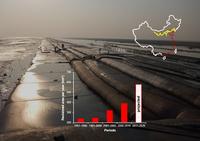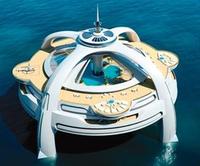-
How much science, math homework is too much?
When it comes to adolescents with math and science homework, more is not necessarily better — an hour a day is optimal — but doing it alone and regularly produces the biggest knowledge gain, according to new research. “Our data indicate that it is not necessary to assign huge quantities of homework, but it is important that assignment is systematic and regular, with the aim of instilling work habits and promoting autonomous, self-regulated learning,” said one of the researchers.
-
-
Louisiana Tech’s concrete canoe, steel bridge teams win big at ASCE competition
The Louisiana Tech University’s American Society of Civil Engineers (ASCE) Concrete Canoe and Steel Bridge teams swept the 2015 Deep South Conference competition in Oxford, Mississippi recently, bringing nine awards back to Louisiana Tech and earning spots in the national competitions. The Deep South Conference competition, which includes teams from universities in Arkansas, Louisiana, Mississippi, and Tennessee, is held annually to enhance student knowledge of techniques, professionalism, and ethics as they relate to civil engineering, and to allow students to apply the principles and concepts they have learned in their undergraduate studies.
-
-
Damage-sensing, self-repairing concrete
Skin is renewable and self-repairing — our first line of defense against the wear and tear of everyday life. If damaged, a myriad of repair processes spring into action to protect and heal the body. Clotting factors seal the break, a scab forms to protect the wound from infection, and healing agents begin to generate new tissue. Taking inspiration from this remarkable living healthcare package, researchers are asking whether damage sensing and repair can be engineered into a quite different material: concrete. Their aim is to produce a “material for life,” one with an in-built first-aid system that responds to all manner of physical and chemical damage by self-repairing, over and over again.
-
-
U.S. engineering schools to educate 20,000 students to meet U.S. major engineering challenges
In a letter of commitment presented to President Barack Obama at the White House Science Fair yesterday, 122 U.S. engineering schools announced plans to educate a new generation of engineers expressly equipped to tackle some of the most pressing issues facing society in the twenty-first century. Each of the 122 signing schools has pledged to graduate a minimum of twenty students per year who have been specially prepared to lead the way in solving such large-scale problems, with the goal of training more than 20,000 formally recognized “Grand Challenge Engineers” over the next decade.
-
-
Lockheed Martin recognized for supporting young girls’ STEM education
Over the next eight years there will be more jobs available in Science, Technology, Engineering, and Mathematics (STEM) than any other occupation. The Society of Women Engineers (SWE) recently presented Lockheed Martin with its first “Invaluable” award for championing education programs that inspire the next generation of women engineers and technologists. Since 2010, Lockheed Martin has given more than $45 million to programs that promote STEM education.
-
-
High school study in math declining among prospective teachers
Math and science participation among New South Wales, Australia high school students has declined starkly over the past decade, which in turn is leading to fewer teachers with this crucial background for their work in schools, according to new research. “STEM is considered critical to all new economies. Yet, unlike many countries which show improving standards on international assessments of math and science, Australian 15 year olds’ scores have been declining since 2000,” said one of the researchers.
-
-
Improving chemistry teaching throughout North America
The Dow Chemical Company and the American Association of Chemistry Teachers (AACT) are partnering to invigorate chemistry education and support STEM (science, technology, engineering, and math) education in the nation’s schools. Dow and AACT will work together to convene a series of teacher summits and create more than 750 lesson plans, multimedia resources, demonstrations, and other high-quality chemistry teaching materials for use in K–12 classrooms. The work will be supported by a $1 million contribution from Dow to the AACT spread over a four year period.
-
-
Consistency, collaboration needed for effective implementation of science teaching standards
A new report just released today by the National Research Council offers guidance to district and school leaders and teachers on necessary steps for putting the Next Generation Science Standards (NGSS) into practice over the next decade and beyond. The report’s recommendations are informed by research findings that emphasize that science and engineering involve both knowing and doing; that developing rich, conceptual understanding is more productive for future learning than simply memorizing discrete facts; and learning experiences should be designed with coherent progressions over multiple years.
-
-
Colleges, labs develop STEM core curriculum
The success of Lawrence Livermore National Laboratory’s Engineering Technology Program to educate veterans for technical careers has inspired a statewide push to create an educational core curriculum to prepare junior college students for technical jobs at California’s national labs. The core curriculum being designed by a consortium of community colleges, national labs, and nonprofit educational institutes emphasizes a heavy focus on science, technology, engineering, and math (STEM) courses to prepare women, minorities, veterans, and other underserved populations for high-paying jobs as technologists.
-
-
Micro-capsules and bacteria used in self-healing concrete
Researchers are aiming to develop a novel self-healing concrete that uses an inbuilt immune system to close its own wounds and prevent deterioration. Self-healing concrete could vastly increase the life of concrete structures, and would remove the need for repairs, reducing the lifetime cost of a structure by up to 50 percent. Over seven per cent of the world’s CO2 emissions are caused by cement production, so reducing the amount required by extending the lifetime of structures and removing the need for repairs will have a significant environmental impact.
-
-
N.M. Electric Car Challenge encourages students’ interests in STEM
Aspiring automotive engineers from twenty-seven middle schools across New Mexico competed in the New Mexico Electric Car Challenge on 22 November at the Highland High School gymnasium in Albuquerque. The goals of the challenge are to present science and math concepts to students in a fun and exciting way, encourage team building, stimulate creative thinking, and develop students’ writing and presentation skills. The New Mexico Electric Car Challenge is a result of the collaboration and commitment of several partners to advance science, technology, engineering, and math (STEM) programs and opportunities for schoolchildren.
-
-
China’s second “great wall” is not so great

China’s coastal regions are only 13 percent of the country’s land area, but contribute 60 percent of its gross domestic product. With that come layers of incentives to turn lush wetlands into engines of development and industry. A new study finds that China’s second great wall, a vast seawall covering more than half of the country’s mainland coastline, is a foundation for financial gain - and also a dyke holding a swelling rush of ecological woes.
-
-
New, updated resource on STEM education, workforce
It just became a lot easier for educators, students, parents, policymakers and business leaders to learn more about national trends in education and jobs in science, technology, engineering, and mathematics (STEM). The National Science Board (NSB) last month released an interactive, online resource featuring new and updated data and graphics about STEM education and workforce in the United States and providing facts on topics such as student proficiency, college degrees in STEM fields, and jobs in science-related occupations.
-
-
Floating cities increasingly attractive prospect in the face of sea level rise, floods

More and more urban planners and disaster managers are asking the question: “Has the time come for floating cities?” Experts say thatin the face of climate change-driven sea level rise and shifting weather patterns poised seriously to impact many cities over the course of the next decades, the option of having cities that can accommodate shifting tides is making more and more sense.
-
-
“Active Physics” incorporates active-learning techniques while still being taught to large classes
Large lecture courses notoriously discourage students from going into the sciences, but an innovative physics course helps to prevent this first-year slide. “Active Physics” incorporates active-learning techniques, but still is taught to large classes. Active Physics consistently outperformed traditional lecture courses in conceptual learning and in attitudes toward learning and problem solving.
-
- All
- Regional
- Water
- Biometrics
- Borders/Immig
- Business
- Cybersecurity
- Detection
- Disasters
- Government
- Infrastructure
- International
- Public health
- Public Safety
- Communication interoperabillity
- Emergency services
- Emergency medical services
- Fire
- First response
- IEDs
- Law Enforcement
- Law Enforcement Technology
- Military technology
- Nonlethal weapons
- Nuclear weapons
- Personal protection equipment
- Police
- Notification /alert systems
- Situational awareness
- Weapons systems
- Sci-Tech
- Sector Reports
- Surveillance
- Transportation
Advertising & Marketing: advertise@newswirepubs.com
Editorial: editor@newswirepubs.com
General: info@newswirepubs.com
2010-2011 © News Wire Publications, LLC News Wire Publications, LLC
220 Old Country Road | Suite 200 | Mineola | New York | 11501
Permissions and Policies
Editorial: editor@newswirepubs.com
General: info@newswirepubs.com
2010-2011 © News Wire Publications, LLC News Wire Publications, LLC
220 Old Country Road | Suite 200 | Mineola | New York | 11501
Permissions and Policies
